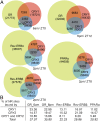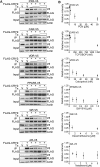Circadian repressors CRY1 and CRY2 broadly interact with nuclear receptors and modulate transcriptional activity
- PMID: 28751364
- PMCID: PMC5565439
- DOI: 10.1073/pnas.1704955114
Circadian repressors CRY1 and CRY2 broadly interact with nuclear receptors and modulate transcriptional activity
Abstract
Nuclear hormone receptors (NRs) regulate physiology by sensing lipophilic ligands and adapting cellular transcription appropriately. A growing understanding of the impact of circadian clocks on mammalian transcription has sparked interest in the interregulation of transcriptional programs. Mammalian clocks are based on a transcriptional feedback loop featuring the transcriptional activators circadian locomotor output cycles kaput (CLOCK) and brain and muscle ARNT-like 1 (BMAL1), and transcriptional repressors cryptochrome (CRY) and period (PER). CRY1 and CRY2 bind independently of other core clock factors to many genomic sites, which are enriched for NR recognition motifs. Here we report that CRY1/2 serve as corepressors for many NRs, indicating a new facet of circadian control of NR-mediated regulation of metabolism and physiology, and specifically contribute to diurnal modulation of drug metabolism.
Keywords: circadian; corepressor; cryptochrome; nuclear hormone receptor; xenobiotic metabolism.
Conflict of interest statement
The authors declare no conflict of interest.
Figures











Similar articles
-
AMPK at the crossroads of circadian clocks and metabolism.Mol Cell Endocrinol. 2013 Feb 25;366(2):163-9. doi: 10.1016/j.mce.2012.06.017. Epub 2012 Jun 28. Mol Cell Endocrinol. 2013. PMID: 22750052 Free PMC article. Review.
-
The Arg-293 of Cryptochrome1 is responsible for the allosteric regulation of CLOCK-CRY1 binding in circadian rhythm.J Biol Chem. 2020 Dec 11;295(50):17187-17199. doi: 10.1074/jbc.RA120.014333. Epub 2020 Oct 7. J Biol Chem. 2020. PMID: 33028638 Free PMC article.
-
The human CRY1 tail controls circadian timing by regulating its association with CLOCK:BMAL1.Proc Natl Acad Sci U S A. 2020 Nov 10;117(45):27971-27979. doi: 10.1073/pnas.1920653117. Epub 2020 Oct 26. Proc Natl Acad Sci U S A. 2020. PMID: 33106415 Free PMC article.
-
Dual modes of CLOCK:BMAL1 inhibition mediated by Cryptochrome and Period proteins in the mammalian circadian clock.Genes Dev. 2014 Sep 15;28(18):1989-98. doi: 10.1101/gad.249417.114. Genes Dev. 2014. PMID: 25228643 Free PMC article.
-
Nuclear receptors rock around the clock.EMBO Rep. 2014 May;15(5):518-28. doi: 10.1002/embr.201338271. Epub 2014 Apr 15. EMBO Rep. 2014. PMID: 24737872 Free PMC article. Review.
Cited by
-
Cancer in the Fourth Dimension: What Is the Impact of Circadian Disruption?Cancer Discov. 2020 Oct;10(10):1455-1464. doi: 10.1158/2159-8290.CD-20-0413. Epub 2020 Sep 15. Cancer Discov. 2020. PMID: 32934020 Free PMC article. Review.
-
JMJD5 links CRY1 function and proteasomal degradation.PLoS Biol. 2018 Nov 30;16(11):e2006145. doi: 10.1371/journal.pbio.2006145. eCollection 2018 Nov. PLoS Biol. 2018. PMID: 30500822 Free PMC article.
-
Off the Clock: From Circadian Disruption to Metabolic Disease.Int J Mol Sci. 2019 Mar 30;20(7):1597. doi: 10.3390/ijms20071597. Int J Mol Sci. 2019. PMID: 30935034 Free PMC article. Review.
-
Circadian Rhythm Dysregulation and Leukemia Development: The Role of Clock Genes as Promising Biomarkers.Int J Mol Sci. 2022 Jul 26;23(15):8212. doi: 10.3390/ijms23158212. Int J Mol Sci. 2022. PMID: 35897788 Free PMC article. Review.
-
BMAL1 and ARNT enable circadian HIF2α responses in clear cell renal cell carcinoma.Nat Commun. 2025 Jul 1;16(1):5834. doi: 10.1038/s41467-025-60904-0. Nat Commun. 2025. PMID: 40595592 Free PMC article.
References
-
- Yang X, et al. Nuclear receptor expression links the circadian clock to metabolism. Cell. 2006;126:801–810. - PubMed
Publication types
MeSH terms
Substances
Grants and funding
LinkOut - more resources
Full Text Sources
Other Literature Sources
Molecular Biology Databases
Research Materials

